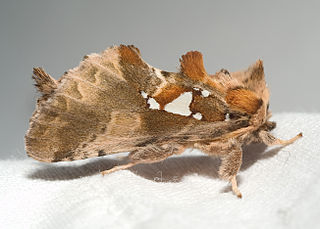
The Noctuidae, commonly known as owlet moths, cutworms or armyworms, are the most controversial family in the superfamily Noctuoidea because many of the clades are constantly changing, along with the other families of the Noctuoidea. It was considered the largest family in Lepidoptera for a long time, but after regrouping Lymantriinae, Catocalinae and Calpinae within the family Erebidae, the latter holds this title now. Currently, Noctuidae is the second largest family in Noctuoidea, with about 1,089 genera and 11,772 species. However, this classification is still contingent, as more changes continue to appear between Noctuidae and Erebidae.
Argentine, Argentinian and Argentinean may refer to:

Notodontidae is a family of moths with approximately 3,800 known species. The family was described by James Francis Stephens in 1829. Moths of this family are found in all parts of the world, but they are most concentrated in tropical areas, especially in the New World. The Thaumetopoeidae are sometimes included here as a subfamily.

Noctuoidea is the superfamily of noctuid or "owlet" moths, and has more than 70,000 described species, the largest number of for any Lepidopteran superfamily. Its classification has not yet reached a satisfactory or stable state. Since the end of the 20th century, increasing availability of molecular phylogenetic data for this hugely successful radiation has led to several competing proposals for a taxonomic arrangement that correctly represents the relationships between the major lineages.

Thaumetopoeidae is a small family of moths in the order Lepidoptera. The genera in this family have been historically treated as a subfamily within Notodontidae (Thaumetopoeinae), and this subfamily has been raised to the family status.
Doidae is a family of Lepidoptera first described by Julian P. Donahue and John W. Brown in 1987. It is sometimes treated as a subfamily of the Notodontidae. Species have been placed in the Arctiidae, Lymantriidae and the Dioptidae.

Notodontinae is the nominate subfamily of the moth family Notodontidae. The Ptilodoninae are sometimes merged herein. The genus list is preliminary, as not all Notodontidae have been assigned to subfamilies yet.

Ptilodoninae is a subfamily of the moth family Notodontidae. They are sometimes merged into the Notodontinae. The genus list is preliminary, as not all Notodontidae have been assigned to subfamilies yet.
Platychasmatinae is a small East Asian subfamily of the moth family Notodontidae. Only two genera are placed here at present:

The Argentine is a moth of the family Notodontidae. It is found in Central and Southern Europe, through Turkey and Iraq, up to Iran.

Dioptinae is a subfamily of the moth family Notodontidae.

The Erebidae are a family of moths in the superfamily Noctuoidea. The family is among the largest families of moths by species count and contains a wide variety of well-known macromoth groups. The family includes the underwings (Catocala); litter moths (Herminiinae); tiger, lichen, and wasp moths (Arctiinae); tussock moths (Lymantriinae), including the arctic woolly bear moth ; piercing moths ; micronoctuoid moths (Micronoctuini); snout moths (Hypeninae); and zales, though many of these common names can also refer to moths outside the Erebidae. Some of the erebid moths are called owlets.
Chrysoglossa maxima is a moth of the family Notodontidae first described by Herbert Druce in 1897. It is found in Panama, Costa Rica and Guatemala.
"Scoturopsis" seitzi is a moth of the family Notodontidae first described by Hering in 1925. It is found in Bolivia.
Euchlaenidia albilinea is a moth of the family Erebidae first described by Schaus in 1912. It is found in Costa Rica.

Ginshachia gemmifera is a moth of the family Notodontidae. It is found in India.
Nystaleinae is a subfamily of the moth family Notodontidae. The subfamily was described by William Trowbridge Merrifield Forbes in 1948.
Heterocampinae is a subfamily of prominent moths in the family Notodontidae. There are at least 60 described species of Heterocampinae in North America.
This page is based on this
Wikipedia article Text is available under the
CC BY-SA 4.0 license; additional terms may apply.
Images, videos and audio are available under their respective licenses.










